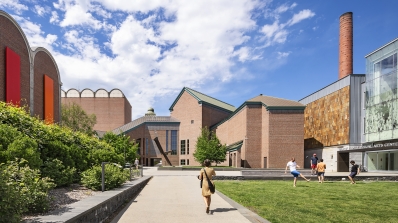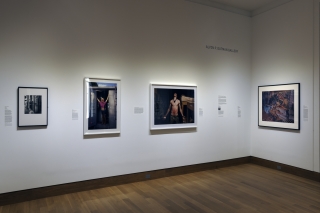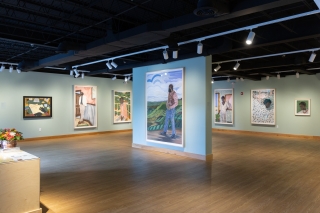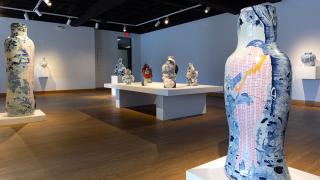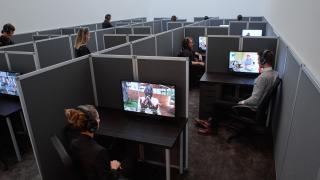Past Exhibitions
The Firmament
Toyin Ojih OdutolaLocation: Hood Downtown, 53 Main Street, Hanover, NH
Stories take center stage in Toyin Ojih Odutola’s drawings. She catches her characters at quiet moments captured from otherwise rich and complex lives. Short on specifics and long on allusion, the narratives she evokes suggest a wide emotional range. We are not meant to know exactly what takes place in these lives, but we are invited into their private spaces and we share an implied intimacy with many of them. Ojih Odutola allows us to peek, but not pry, into the lives of those who occupy her personal firmament. The artist establishes a compassionate confrontation between viewer and subject through the use of scale and through her extraordinary mark-making technique that draws us close to her surfaces. Many of the drawings are life-sized, some even full-length. This reinforces an uncanny sense that we share a space with her subjects; it also establishes an equivalence between viewer and subject.
Ojih Odutola’s signature drawing technique rewards close scrutiny. She creates small patches of color from carefully hatched lines to show skin; each plane works to delineate the exposed volumes of her sitter’s body. This technique is notably reserved for the depiction of skin; she draws clothes, furniture, and even the landscape in a looser, more broadly marked technique.
Past Forward
Sin-ying HoLocation: Hood Downtown, 53 Main Street, Hanover, NH
If Chinese ceramic art has a heart, it beats in Jingdezhen. For centuries, artisans there have made vessels that traveled far and wide. Their fluid forms and recognizable decorations have inspired celebratory prose and devoted followers around the world. Today, Sin-ying Ho works in these same ceramics factories. Though Jingdezhen potters have long defined tradition, Sin-ying has expanded both their forms and their imagery in contemporary ceramics that are thoroughly of the twenty-first century. She makes her works—whether they are monumental vases or smaller, more clearly assembled sculptures—from multiple parts. She emphasizes the many parts by glazing each of the pieces differently. Together they form a whole that maintains the legacy of being created from myriad fragments.
Sin-ying’s process of building is an essential metaphor for her artistic practice. With it, she implies an optimism for our society’s continued ability to construct a unified world. As reflected in her technique, and in the themes addressed by her surface imagery, this world will necessarily be an amalgam of new and old, here and there, greed and generosity, men and women, faith and despair. Through these combinations, Sin-ying shares a worldview that acknowledges the inherent contradictions and challenges of global culture while also anticipating the uncanny beauty emerging all around us.
Reason’s Oxymorons
Kader AttiaLocation: Hood Downtown, 53 Main Street, Hanover, NH
Reason’s Oxymorons, by internationally acclaimed artist Kader Attia, is a recent museum acquisition. The research-driven video installation, which will occupy the entire space at Hood Downtown in winter 2018, consists of a range of interviews by Attia with philosophers, psychiatrists, anthropologists, traditional healers, historians, musicologists, patients, and immigrants. The conversations are organized around several themes centered on the ways in which non-Western and Western cultures approach psychiatric conditions and emotional breakdowns. Composed of eighteen computer monitors, each set on a workman-like table in a secluded office cubicle with a chair, earphones, and loudspeakers, this ambitious installation evokes an ascetic modern office environment.
Sound Art at Dartmouth
Resonant SpacesIn the first-ever installation of sound art on Dartmouth's campus, produced in collaboration with guest-curator faculty member Spencer Topel, the Hood Museum of Art will showcase the work of emerging and established international artists with diverse aesthetic and cultural backgrounds. Seven site-specific and sound-based commissions will guide visitors across the Dartmouth campus and into the town of Hanover. Hood Downtown will feature a multimedia display introducing the exhibition and artists, as well as selected works from conceptual artist Terry Adkins (1953-2014). Artists creating new installations for the show include Bill Fontana, Christine Sun Kim, Jacob Kirkegaard, Alvin Lucier, Laura Maes, Julianne Swartz, and Jess Rowland.
As diverse a medium as bronze or oil paint, sound can be recorded from the environment or produced from an object, sculpture, instrument, or living being. It can be responsive to installed spaces or autonomous, continuous or intermittent, loud or soft. Artists were invited in part for the compelling ways they use sound through conceptual, visual, and architectural contexts. Resonant Spaces alters locations in Hanover by encouraging visitors to experience the world transformed through sound.
